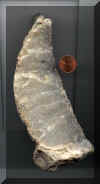Several types of fossils can be found on the sand and gravel bars in Spring Creek, particularly after floods expose them.
Austin Chalk: Below is a photo of the fossil-bearing Bruceville Marl which runs along the Blackland Prairie south through Austin. The middle Austin Group at Spring Creek Forest is approximately 86 to 87 million years old. The composition of the calcium carbonate chalk includes the remains of small marine plankton such as foraminifera and nannoplankton such as coccolithophores. According the Texas Bureau of Economic Geology, “tan to white chalk beds are composed of partly recrystalized, fragmented nannoplankton matrix having 5 to 25 percent foraminifers and whole or fragmented inoceramid pelecypods.” Foraminiferans or “forams” can be seen in the Foram Gallery. Coccolithophore information can be found at the “Ehux” Home Page. In addition to coccoliths, other nannoplankton include nannoliths, silicoflagellates and calcispheres.
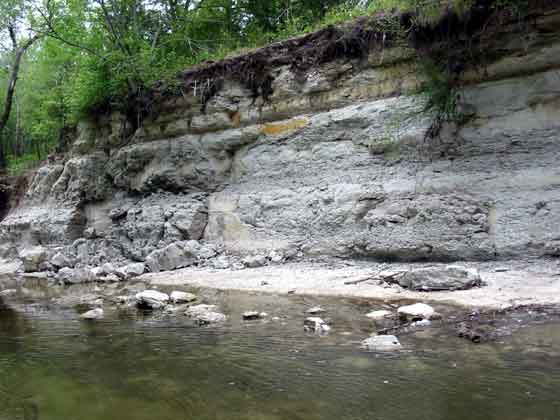
Keith Minor’s geologic and paleontologic description for Spring Creek:
The Atco Chalk (creek and banks), Bruceville Marl, and probably the Hutchins Chalk (top of exposure) are all expose along the creek.
Lower Hutchins Chalk (probably present)
Pseudoperna congesta (Conrad) found
Bruceville Marl (most of the exposures at Spring Creek)
Inoceramus (Platyceramus) platinus (Logan) found
Pseudoperna congesta (Conrad) found
Exogyra ponderosa found
Texanites (Plesiotexanites) stangeri densicostatus (Spath) found
Texanites sp. indet. found
Upper Atco Limestone (creek level)
Inoceramus (Cremnoceramus) crassus inconstans (Woods) found
Inoceramus (Cremnoceramus) crassus crassus (Petrascheck) presumed present but difficult to identify fragments
Inoceramus (Cremnoceramus) deformis dobrogensis (Szasz) found
Inoceramus (Cremnoceramus) deformis deformis (Meek) presumed present but difficult to identify fragments
Badly weathered oysters of Exogyra ponderosa Roemer were also found loose along the banks, but I did not find any in strata. I’m not sure about the Hutchins because I didn’t see any of a distinct species called Inoceramus (Cladoceramus) undulatoplicatus (Roemer), which occurs at the top of the Bruceville Marl according to reports.
BIVALVES
Exogyra ponderosa (Roemer, 1849)
This marine bivalve, a fossil oyster, is generally found in the lower third of the Austin Chalk Group. Specimens can weigh several pounds. This one was found on Feb. 19th at Spring Creek. Recently snowmelt and stormflow apparently washed it downstream. This is the same location where the coral specimen was found three years ago. (For size comparison is the Asiatic clam, Corbicula manilensis. This small clam was originally introduced to Washington State in 1938. Since then the clam has invaded almost every watershed in the United States). Interesting to see ancient marine fossil side by side w. modern-day freshwater bivalve.
http://home.houston.rr.com/lundquist/Field_Trip/trip.html Virtual Field Trip to the Austin Chalk Group
http://crnmac1.physics.uiowa.edu/fossils/oysters/Exogyra/index.html Good collection of Exogyra photographs
RudistsIt’s a piece of a large rudist (or rudistid) Clam called Durania austinensis (Roemer, 1852). Roemer’s original figures and several additional photographed specimens in the literature corroborate the ID.
Reports include: 1) the Terlingua Group, Pen Formation of West Texas, 2) the Terlingua group, top of the Boquillas Formation ( top of San Vincente Member), 3) the upper Austin Group of central and north Texas, 4) the Taylor Group, Ozan Formation, 5) the Taylor Group, Pecan Gap Chalk of central Texas (from Bell, Brewster, Fannin, McLennan, and Travis Counties). Your specimen adds Dallas County to the list (upper Austin Group).

Inoceramus (Cremnoceramus) deformis dobrogensis (Szasz) (Giant clam), Cretaceous Period. This large and ruggedly built bivalve once lived in the area of breaking waves in an ancient sea in central Texas which accounts for it’s extra thick shell. Keith Minor identified the fossil and provided additional information:
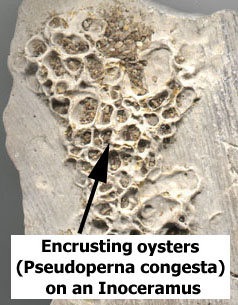
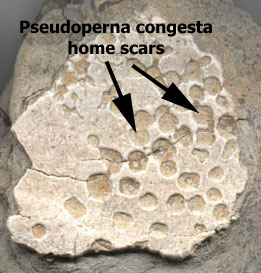
The above photos are of encrusting oysters on an inoceramid, probably Inoceramus (Platyceramus) platinus (Logan)or fossil bivalve.. These encrusting oysters are called Pseudoperna congesta. Thanks Keith for the id’s.
The right piece is an Inoceramid showing the home scars of Pseudoperna congesta (holes where the clams encrusted the Inoceramid). You can tell that it’s an Inoceramus shell by looking at the shell in cross-section. You’ll see a fibrous cross-section typical of Inoceramid shells. I’ve had people insist that pieces of Inoceramus are bone, because of this misleading look to the shell. Some times they’re beige pieces with suture looking breaks, so it’s easy to mistake it. Keith reported: “I also found LOTs of Inoceramus (Platyceramus) platinus (Logan) in the rocks. This is a longer ranging Ino that can be found throughout the Austin Group in the Dallas/Garland/Richardson area (Atco Limestone, Bruceville Marl, Hutchins Chalk). In some places, you can see the cross-sections of countless huge platinus’s! This is probably the species in your images with the Pseudoperna congesta (Conrad) home/attachment scars. Speaking of which, I found countless numbers of those oysters at Spring Creek.”

Fossil wood is the most common find on gravel bars in Spring Creek.
AMMONITES
Please help identify this fossil….was located at Beck Branch in Richardson Texas…..a tributary to Rowlett Creek in the same major drainage as Spring Creek. Click on thumbnail to enlarge. Photo taken 2/22/07. Specimen was in rock which had broken off the adjacent cliff face. Looks similar to Parapuzosia americana from Middle Austin Group formation.
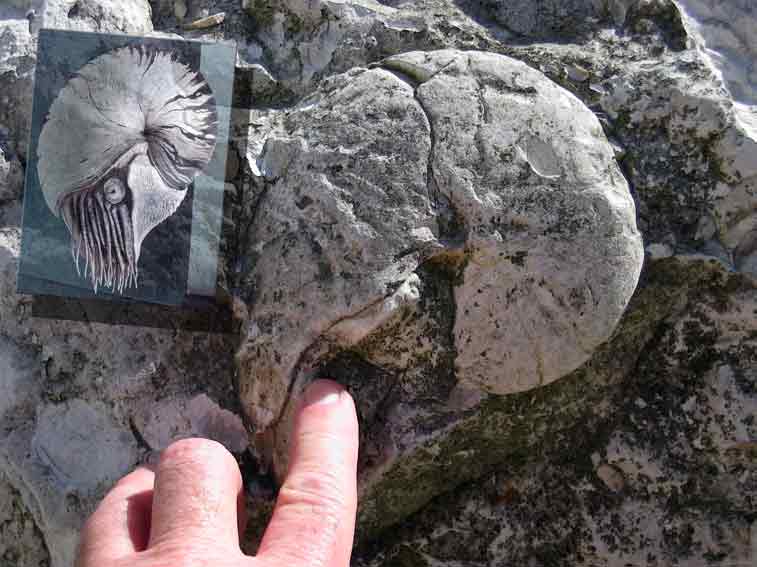
This Keith Minor’s report on Spring Creek ammonites:
These ammonites indicate an Early Santonian to Late Santonian age for the top of the creek exposure, and also indicate that not only is the Atco exposed there, but the Bruceville and Hutchins fms are also present. If you look at the Geologic Atlas of Texas, Dallas Sheet, these should be the main formations exposed at the creek.Photo taken July 15, 2006 on lowest formation exposed along Spring Creek close to Maple Ridge Drive.
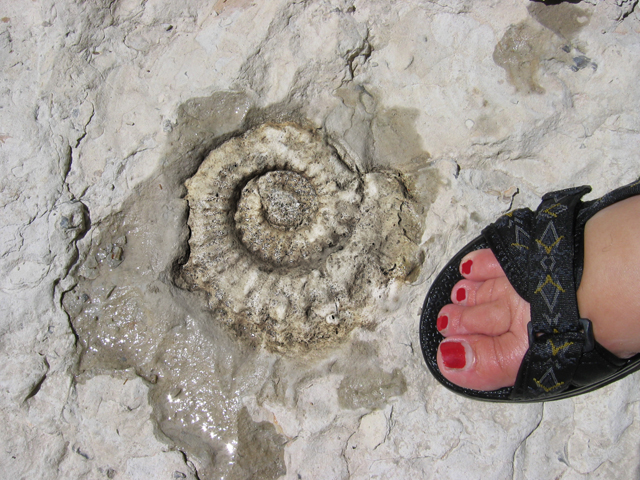
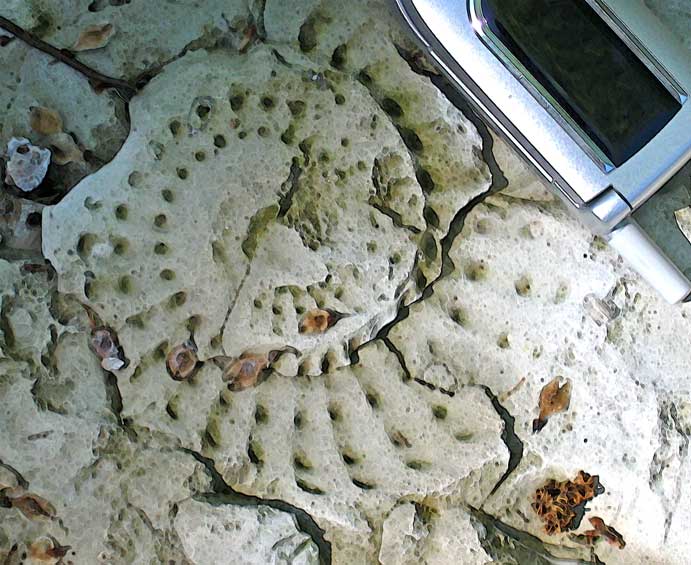
Above: April 11, 2007: Same fossil after a section split off due to recent high spring flows or possibly vandals….The internal structure is revealed.
Special thanks to Keith Minor for most of the fossil identifications as well as Rocky Manning’s identification.
Other links:
Calcareous Nannofossils – USGS site
Mosasaur – Found in Duck Creek, July 2008 Photos
Below: four types of Mosasaurs:
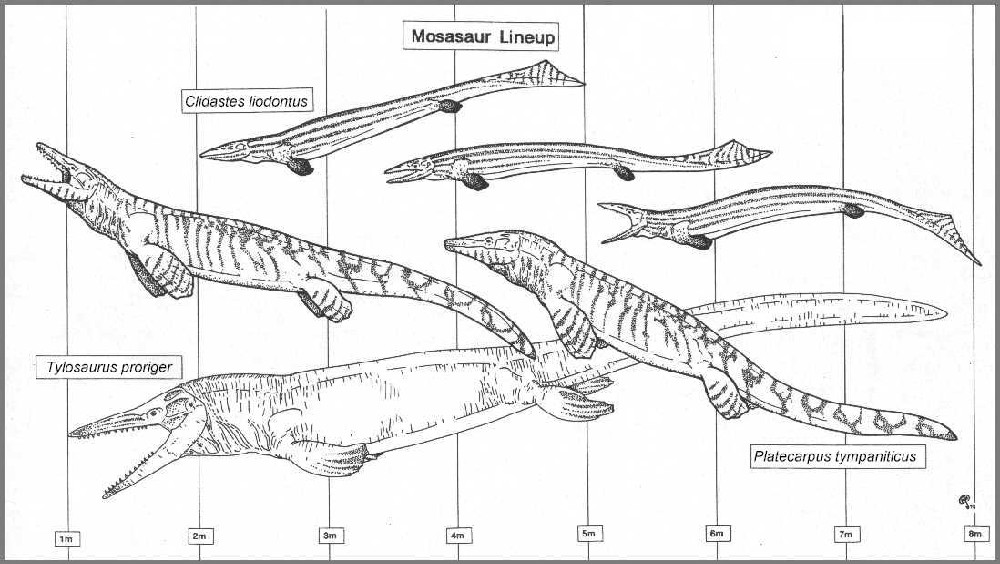
DanaAAllen’s Flickr site showing fossils from the North Sulphur River.
Arlington Archosaur Site – recently discovered crocodile bones (Woodbinesuchus sp.)
For more information on the Arlington Archosaur Site, try these links:
National Geographic on the Arlington Archosaur Site
UTA Shorthorn newstory on the Arlington Archosaur Site
UTA Archosaur Project; Fox 4 Lone Star Adventures story
Dr. Christopher R. Scotese’s PaleoMap Project
Dallas Morning News story & video on the Arlington Archosaur Site
Ft. Worth Star Telegram story on the Arlington Archosaur Site
The Society of Vertebrate Paleontology
SMU Earth Sciences Department
Protohadros Wikipedia Webpage
Lone Star Dinosaurs Exhibit
Arlington Archosaur Site Facebook Group
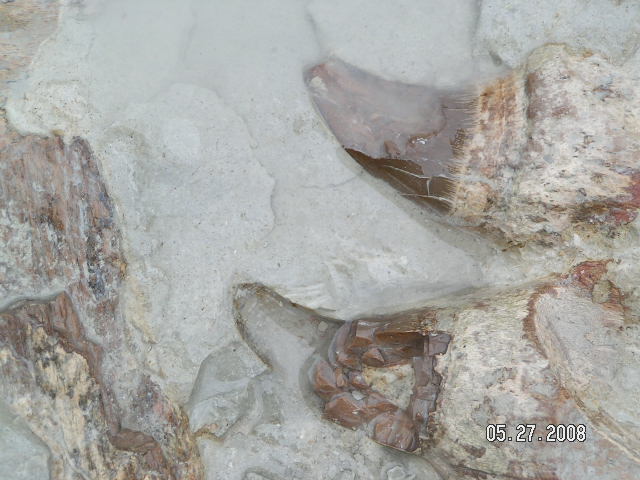
Dallas Paleontological Society
(Below) is a mineral, not a fossil, but still interesting…these are pyrite nodules in Austin chalk Atco Formation found in Duck Creek located sw of Spring Creek. Pyrite is the classic “Fool’s Gold”. Pyrite crystal usually forms as a cube, which can be seen if you magnify these pyrite nodules. Less commonly, it forms as octahedrons (eight-sided shapes), nodules, or massive forms. It can also occur as coarse granules.





